Crabgrass is one of those weeds that grow even in the toughest conditions. This makes it a daunting weed to eliminate for homeowners who want to grow thick, lush, and healthy lawns.
This invasive weed can quickly take over your lawn if not properly controlled with the right techniques.
Quick Answer
The answer to how to get rid of crabgrass and prevent it in the summer and spring involves several steps and methods I’ve used successfully:
- Pulling crabgrass by hand
- Using baking soda
- Applying corn gluten
- Applying a crabgrass herbicide (Preferably a selective herbicide containing Quinclorac)
Read on to find out whether you should use natural or chemical ways to get rid of crabgrass for good and the best options available.
Affiliate links and images pulled from the Amazon Product Advertising API on: 2024-05-12
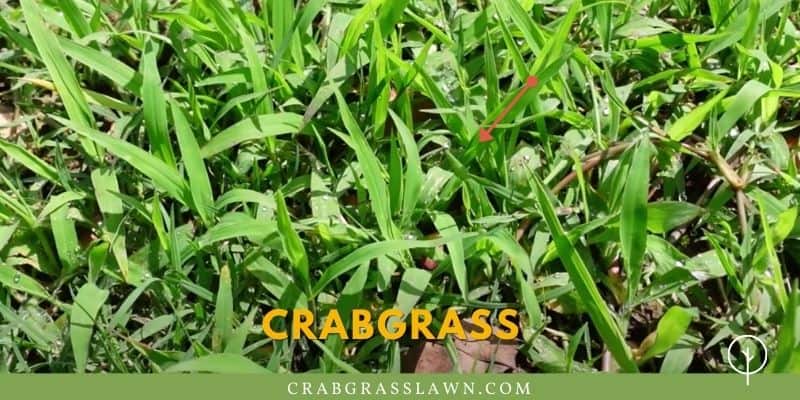
Crabgrass taking over my neighbor’s garden.
Timing to Get Rid of Crabgrass for Good
Crabgrass is a grass just like other grasses on your lawn. Applying combination herbicides won’t get rid of it. Timing is important if you want to get rid of this weed permanently.
There’s a big difference between controlling perennial grass weeds and annual grasses. Annual and bi-annual grass weeds have a period of dormancy while crabgrass thrives all year round. That is why it is a perennial weed. Learn about the lifecycle of weeds.
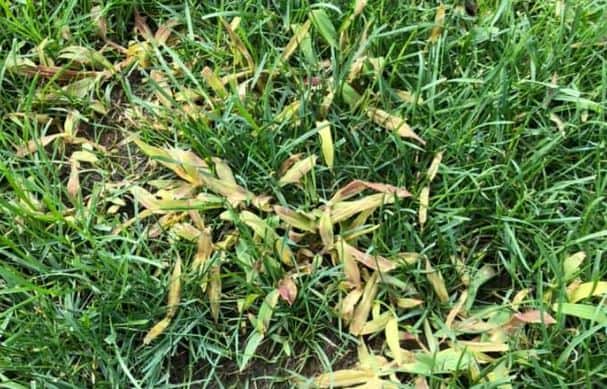
Crabgrass thrives in the spring and summer (March-Oct). Here are two timing tips that will help you get rid of crabgrass in your lawn:
- For spring, just before the germination of this weed, apply a pre-emergent herbicide. This will prevent the seeds from germinating on your lawn. I use Tenacity and typically put it out in February in my Bermuda lawns.
- In the summer, or when you are starting to see sprouts, use a potent crabgrass post-emergent herbicide to kill already existing weeds in your lawn. For this, I use Quinclorac and spray it on the areas where I see growth. If you have St. Augustine or Centipede grass use a product called Celsius.

As you can see, understanding the life cycle of this lawn weed is key to eliminating it for good. Here’s a summary of what you need to keep on your calendar to control this weed.
| Spring | Soil temperature = 55 – 60 degrees Fahrenheit. Crabgrass seeds germinate | Apply a pre-emergent herbicide for crabgrass control. |
| Mid-summer – Fall | Warm weather; crabgrass is flowering and producing seeds. | Apply a good post-emergent herbicide, or uproot. |
| Winter | Cold temperatures, dormant crabgrass seeds. | Prepare to apply a pre-emergent. |
How to Kill Crabgrass Naturally?
The best, natural way to get rid of crabgrass and perennial weed grasses is to dig them out rather than spraying them with Roundup or another herbicide of your choice. But that’s not the only way. Below, I’ve detailed different ways to eliminate this weed using organic methods as well as chemical methods.
1. Pull out the crabgrass (By hand or using a tool)
Even if you use a herbicide to get rid of crabgrass weed, you’ll still have to dig it out to completely get rid of it. However, using a chemical is not one of my favorite methods because it has detrimental effects on the surrounding lawn grasses.
I prefer removing crabgrass naturally, which involves digging it up. It is a great way of eliminating the weeds without killing lawn grass. Here are a few other reasons to remove weeds by hand.
Here’s a simple way to pull out crabgrass:
- Water the spots with crabgrass for about 30 minutes to soften the soil.
- Use a claw weeder or a pitchfork to uproot crabgrass. You can also use your hand if there are just a handful of spots infested.
- Add rooting fertilizer or organic manure to the area.
- Reseed the bare spots in your lawn with good grass seed to regrow freshgrass.
- Care for the new grass as usual.
Early in the spring, the shoots of crabgrass are still short. You can pull them out of your lawn and manage to get rid of them successfully, unlike in the summer when the weeds are extensively grown.
Crabgrass has a crab-like root system. While it’s easier to uproot, you may want to use a claw weeder to make your work a lot easier. It uproots invasive weeds including crabgrass, dallisgrass, dandelions, etc.
My favorite claw weeder is the Fiskars 39″ 4-Claw Weeder.
(Click the link to see a video of how it works on Amazon).
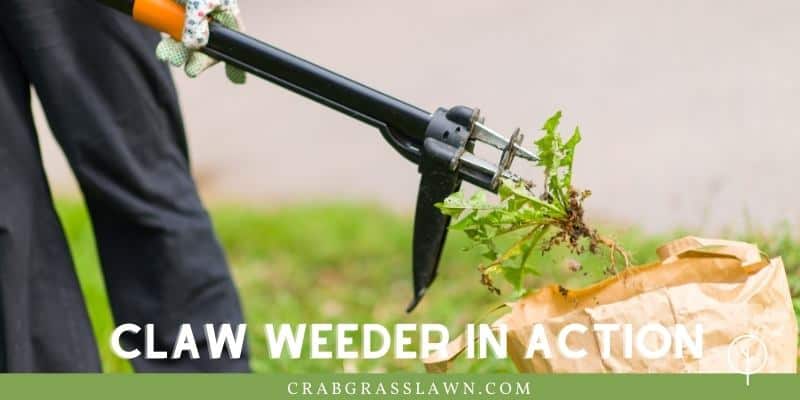
Digging and uprooting can also cause a little damage to your lawn, so be careful not to end up with a sodding job to do especially if there are extended areas invaded with crabgrass.
2. Killing Crabgrass With Baking Soda (Natural Crabgrass Killer)
Baking soda is a phytotoxin and will damage almost any plant leaves it comes in contact with. The phytotoxic effects are presumably due to the sodium content.
Even at % concentration, baking soda can start to kill crabgrass in your lawn. Making a solution out of it may not produce great results on lawn weeds, so the preferred method is to use its powder.
Here’s how to get rid of crabgrass naturally by applying baking soda.
- Spray a little water on the crabgrass and other weeds in your lawn.
- Sprinkle baking soda powder on the weed.
- Allow a few days for it to destroy the weeds.
- Uproot the dead weeds and replant grass to fill in the spots
Caution: Baking soda will kill any plant it comes adequately in contact with. Fescues, Bermuda grass, St. Augustine or even Kentucky Bluegrass lawns will get damaged if you apply baking soda on their leaves.
I would recommend using baking soda on single patches of crabgrass rather than extended invasions. Check out my detailed guide on using baking soda as a weed killer and its side effects here.
3. Apply Corn Gluten (another natural option)
Corn gluten is one of the recommended organic crabgrass preventers. The best part is that it also works as a lawn fertilizer due to its high nitrogen content (10% by weight). It works by inhibiting crabgrass seeds from forming roots after germination.
The Jonathan Green Corn Gluten Weed Preventer is a solid product that works great organically.
According to the findings by Iowa State University, corn gluten meal can be put down as a pre-emergent to prevent crabgrass and other weeds that germinate in spring.
However, the University of Maryland Extension notes that corn gluten does not prevent the germination of crabgrass. It only controls it by feeding lawn grass with sufficient nitrogen. In turn, the lawn grass ends up growing faster, choking out crabgrass.
4. Use Vinegar to Get Rid of Crabgrass Organically
Will vinegar kill crabgrass?
Vinegar is an organic solution that kills crabgrass and other weeds. To control crabgrass naturally, apply at least 20% vinegar on the weed, 30% is better for tougher weeds. Don’t use standard vinegar that you would buy for cooking. You need horticultural vinegar and here’s why!
The organic solution will affect the cell membranes of the weed, causing rapid breakdown/desiccation of foliage tissue on contact.
Here’s how to use vinegar to get rid of crabgrass naturally:
- Add vinegar, salt, and dish soap in a plastic mixing cup
- Stir with a plastic spoon to mix the ingredients well.
- Pour a moderate amount of this vinegar solution on crabgrass.
- Repeat steps 2 and 3 above on all instances of weeds in your lawn.
See my vinegar-based weed-killer formula.
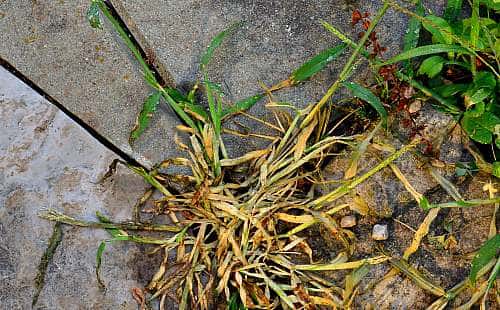
This homemade solution can use household vinegar as an ingredient. It is much weaker than the commercial-grade organic vinegar weed killer. With a 20% or 30% concentration, simply pour the solution on the weed and let it die off naturally.
Note that you want to use herbicidal and not household vinegar. Herbicidal vinegar is an organic concentrate that acts as a non-selective herbicide for lawns. It can kill broadleaf and grassy weeds altogether.
Be careful not to apply it on your grass because it will kill any plant it comes in contact with.
Vinegar organic herbicide acts in the same way Roundup does. It will kill weeds (and any other plant it comes in contact with) to the root.
5. Burning Weeds
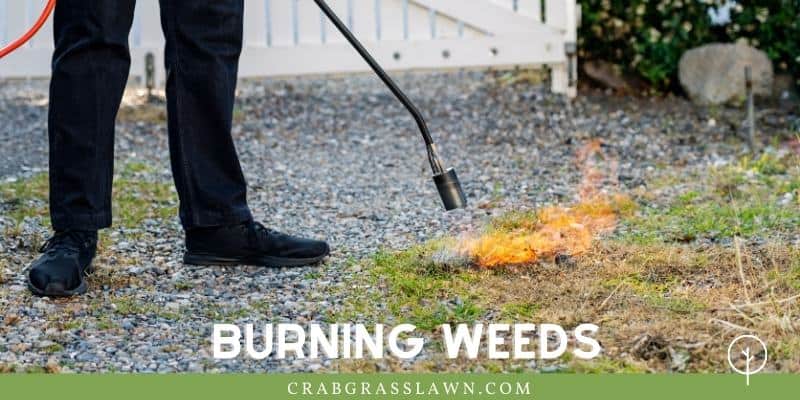
You can burn crabgrass to remove it from your yard using a heat gun, a blow torch, or a weed burner. This exposes the weed to extreme heat, which kills the cells in the leaves and the stems. The weed will not be able to manufacture food and it will die off instantly.
Remember, crabgrass does not spread through underground stolons. It is very easy, therefore, to control it by using a weed burner.
I would recommend this method for single instances of crabgrass in your lawn as opposed to widespread areas of weeds, especially if you’re using a normal blow torch.
Burning is a great way to kill grassy weeds without chemicals. Natural methods are the best and the ash goes right into the soil to feed it.
Use the Flame King Weed Burner as this is a great tool and I have used it multiple times to control weeds.
CAUTION: Do not attempt to burn crabgrass in a dry lawn. You risk grass fires that are dangerous because they spread quickly. Even on a green lawn, ensure you put safety measures in place, such as a standby garden hose with water in case a small fire starts.
Here’s a video on how to control crabgrass without chemicals using a weed burner.
How to Get Rid of Crabgrass with Herbicides?
Apply a Crabgrass Killer Herbicide
First, identify what grass you have as there are different products for different grass types.
For Bermuda, Zoysia, Buffalograss, Ryegrass, Tall Fescue, & Kentucky Bluegrass: Use a product with Quinclorac such as this one:
- KEY FEATURE: Selective, post-emergent herbicide that can be safely applied to many types of turf to control a variety of broadleaf and grassy weeds
- USE SITES: Residential Turfgrass & Non-Residential Turfgrass
- EFFECTIVE AGAINST: Crabgrass (large & smooth), Foxtail (giant, green & yellow), Kikuyugrass, Signalgrass (broadleaf), Torpedograss, Bindweed (field), Clover (hop, red & white), Daisy (english), Dandelion, Dollarweed, Geranium (Carolina), Morningglory spp., Speedwell (common, slender & thymeleaf)
Affiliate links and images pulled from the Amazon Product Advertising API on: 2024-05-12
Then add a Surfactant product such as Methylated Seed Oil Duo Stick (Use BOTH for maximum effectiveness)
If you want to treat more than just crabgrass, then you can mix Quinclorac with T-Zone and you’ll treat all your weeds.
Mix the herbicides (quinclorac/t-zone/Surfactant) and then simply spot-spray the areas with crabgrass and let it dry for 24 hours (don’t water it in). See my best weed sprayer guide here.
You should, however, know that crabgrass should be treated in the spring with a pre-emergent. It helps a lot to stop the germination of weeds and will make your weed control over the summer much easier.
If you find some small breakouts of crabgrass, then treat it with an over-the-counter herbicide. The most effective herbicides are those containing quinclorac as the main ingredient. I prefer Primesource Quinclorac Liquid Crabgrass Killer because it works fast and effectively.
For Buffalograss, Centipedegrass, Fine Fescue, Kentucky Bluegrass, and perennial Ryegrass:
Another great option you can use is a herbicide with mesotrione as an active ingredient. A good example is Tenacity Turf Herbicide. I use Tenacity, with Surfactant, and Lazer Blue Dye on my neighbor’s yards all the time. So be sure to pick up all 3 of those products for the best results. Just click the link above for Tenacity as that is the lowest price I have found for it online.
After you apply Tenacity, wait around 5-7 days before mowing. Around the 10-day mark, you will start to see the bleaching effect on your crabgrass.
For St. Augustine Grass use Celsius with a Surfactant
Affiliate links and images pulled from the Amazon Product Advertising API on: 2024-05-12
Sponging with Roundup
Sponging or spot-treating is a great chemical technique to get rid of crabgrass and other perennial grasses in your lawn. It is different from spraying because you don’t want to affect the good grasses in your lawn.
Here’s how to get rid of crabgrass by sponging or spot-treating:
- Mow around the crabgrass for about 2 weeks to allow the weed to grow taller than your lawn.
- Put some Roundup herbicide in a bucket and mix with a surfactant or sticking agent.
- Dip a sponge in the Roundup and lace the top part of the crabgrass (2-3 inches of the grass blades).
- Repeat this process 2 to 3 times over two weeks to allow the herbicide to kill the entire weed.
With sponging, the glyphosate in Roundup goes underneath and travels down the grass weed, killing it to the root. Glyphosate is a non-selective herbicide that can easily kill perennial weeds as well as your lawn grass.
To get rid of crabgrass without killing lawn grasses such as Bermuda grass or St. Augustine, ensure that you don’t apply too much Roundup.
If you do, you’ll end up with a ring of death around the area you applied the chemical.
I compiled a full list of effective Crabgrass Killer herbicides.
How to Get Rid of Crabgrass without Killing Grass?
If you have a handful of crabgrass weeds in your lawn, you can treat them with Scotts Spot Weed Control. This product will kill crabgrass but won’t harm your grass when used as directed.
- Spot weed control for lawns
- Kills dandelion, Clover, and crabgrass
- Will not harm lawns
Affiliate links and images pulled from the Amazon Product Advertising API on: 2024-05-12
You can prevent crabgrass in your lawn by applying a pre-emergent herbicide before crabgrass seeds germinate. If you don’t want to apply a chemical treatment to kill crabgrass, the citric acid found in several fruits can be used to kill crabgrass naturally without killing the grass in your lawn.
How Long Does It Take to Kill Crabgrass?
The amount of time it takes to kill crabgrass depends on the solution you’re using, where some may take longer than others.
How Long Does It Take for Vinegar to Kill Crabgrass?
There’s no definite amount of time vinegar takes to kill crabgrass, where it could be a couple of days to a few weeks.
Vinegar is an acid that will kill the leaves of crabgrass first before moving to the weed’s root system, after which the weed dies permanently. Once the crabgrass dies after a vinegar application, your lawn will be free from weeds for up to 13 weeks.
In most cases, vinegar kills crabgrass and many other weeds in roughly 24 hours after application.
How Long Does It Take Quinclorac to Kill Crabgrass?
The crabgrass weeds will start to yellow and wilt after the third day following a Quinclorac application.
You can expect the crabgrass to be dead by the 10th day after spraying the weeds with Quinclorac. Quinclorac is a post-emergent herbicide that kills crabgrass even in its mature stages.
How Long Does It Take for Tenacity to Kill Crabgrass?
Tenacity kills crabgrass in up to 3 weeks after application. The foliage of the crabgrass ceases growth after application, then white indicating a loss of chlorophyll after the weeds eventually die.
A repeat application of Tenacity may be needed after 2 to 3 weeks for improved post-emergence weed control.
How Long Does It Take Baking Soda to Kill Crabgrass?
Baking soda is a salt that kills crabgrass owing to its phytotoxic effect. This remarkable weed killer absorbs the water from the plant’s tissue and you should see signs of desiccation within a few hours after spreading the baking soda concoction.
Next, the crabgrass leaves will start to wilt and may appear black or brown – an indication that the baking soda is doing its job.
How to Control Crabgrass (Prevention Options)
Timing is key when it comes to controlling and preventing crabgrass in your yard. From experience, if you wait too long, the weed will take root and you’ll find it hard to control it.
Here are 3 great ways of controlling crabgrass on your lawn:
Put down pre-emergent on time
What you want to do is control crabgrass early in the season, probably during the second mowing or so. During this time, you can use a crabgrass control product, usually called a pre-emergent or preventer. See my guide and tips on the best time to put down a crabgrass preventer.
I usually recommend choosing a crabgrass pre-emergent that contains fertilizer in it. One of my preferences for this is the GreenView Weed & Feed + Crabgrass Control product.
Affiliate links and images pulled from the Amazon Product Advertising API on: 2024-05-12
If you opt to try this product, ensure you choose one that contains time-release nitrogen in it to prevent burning out your precious lawn.
Overseeding Your Lawn
Overseeding is one of my favorite techniques for weed control and keeping my lawn lush green and thick. It is a simple technique of planting grass seed directly into the existing turf without having to go through the normal preparation procedures.
The result of an overseeded lawn is a thick, dense lawn and filled-up bare spots. But how does that control crabgrass weeds?
- The thick lawn grass chokes out any existing crabgrass, thus killing it naturally.
- An overseeded lawn prevents crabgrass from germinating, thus controlling it a lot more effectively.
You can overseed your lawn in either the fall or early spring, allowing the grass enough time to germinate and grow before the crabgrass starts growing in the summer.
Grow a thick, healthy lawn
Nothing beats a healthy, thick lawn. Even weeds struggle to germinate and outgrow a lawn that’s thick and dense. If any crabgrasses are germinating in your lawn, you can choke them out easily especially early in the season with a thick lawn. But how do you make your lawn dense?
Here’s how to grow a thicker lawn and choke out crabgrass weeds:
- Water your lawn only once a week to promote a deeper, stronger root system. Watering more than once makes your lawn develop weaker roots, making it more vulnerable to tenacious grass weeds.
- Mow your lawn higher than you’re used to. It is recommended that you leave your lawn 2 – 3 inches higher to crowd out crabgrass and prevent it from growing.
- Aerate and dethatch your lawn at least once a year. This is especially good for turfs with clay soil in them. Lawn aeration will help improve oxygen circulation and promote a healthier, thicker lawn.
- Fertilize your lawn enough especially if it is Bermuda grass. However, you want to use a time-release nitrogen fertilizer to control weed growth.
- Reseed or overseed in the fall to prevent crabgrass. But why in the fall? Fall is a season of warm days and cool nights. This will promote the healthy growth of lawn grass especially when there’s dew in the morning.
Summer Crabgrass Control Tips
How to Get Rid of Crabgrass in the Summer?
Even though there are several ways to crabgrass removal and crabgrass control in the summer, the most common methods are by hand-pulling or with a herbicide.
It’s worth mentioning that crabgrass dies on its own each year in the fall so the weed will be dead by winter if you can wait it out.
If you have small crabgrass infestations, simply pull them up by hand, which will get rid of the weeds with their roots.
But if your lawn is plagued with crabgrass, using a herbicide is the best way to kill crabgrass as it would take you forever to pull them up by hand, which needless to say is a daunting task.
FAQs
What Causes Crabgrass?
Crabgrass thrives in areas that receive excessive sunlight and in areas that have thinning grass. Crabgrass also loves sandy, compacted soil and favors soil temperatures between 55° and 65°F.
Why Is My Lawn Full of Crabgrass?
Crabgrass favors weekend areas of your lawn where the grass is thinning as the sunlight directly hits the soil and encourages crabgrass germination.
Final Thoughts
Crabgrass is a pesky broadleaf weed that can quickly take over your lawn. But the good news is that there are several ways to get rid of crabgrass in the summer and spring including natural and chemical treatments.
References
- University of Maryland Extension: Is Vinegar an Alternative to Glyphosate?
Hi, Alex Kuritz here. Growing up I remember that my family had one of the best lawns in the neighborhood. Richly green and lush. I did a lot as I grew up in terms of caring and tending for not only my family’s lawn but also my neighbors. I can say I have years of experience, and I am here to share it with you.








I need to pick up a pre-emergent for my Bermuda grass in Texas and I cannot find Spectracide weed stop for lawns anymore in the 10 lb bags. They only had Scott weedex. Is scotts comparable? I need a broad spectrum that will take care of sedge, crabgrass, and other spring-summer weeds.
I also need to use the same stuff for fall/winter.
Someone recommends getting Sunniland 50lb bag (0-0-7) for $25 and you should have enough for many applications for a while. Then just treat with the Spectracide Spray for post-emergent.
Look for products that contain Quinclorac. They will usually say kills crabgrass in big letters on the front of the bottle. I use Barricade and Dimension as pre-emergents and various ready to spray herbicides that are marked as being effective on crabgrass. Just make sure that it’s listed as being safe for your type of grass. Different formulations could be harmful if applied to the wrong grass type.
How do I kill the crab grass and not kill my roses?
Check out Tenacity.